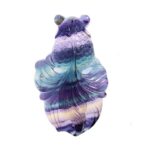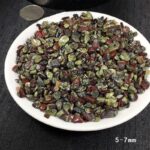Blacklights illuminate a hidden world of colors and patterns, transforming ordinary objects into glowing masterpieces. Understanding which colors fluoresce under ultraviolet (UV) light is essential for harnessing its transformative power. Discover the colors that shine brightest, unleashing vibrant possibilities for art, fashion, and everyday life.

The Science Behind Blacklight Fluorescence
Blacklights emit ultraviolet radiation, which lies beyond the visible light spectrum. When these rays strike certain pigments, they absorb the energy and re-emit it as visible light, creating a glowing effect known as fluorescence. The wavelength of the absorbed UV light determines the color of the emitted glow.
Colors That Glow Brightest Under Blacklight
Not all colors fluoresce under blacklight. Here are the colors that shine most brilliantly:
- White: White reflects all wavelengths of light, making it an excellent choice for objects that need to glow brightly.
- Neon: Neon colors, such as pink, yellow, green, and orange, contain fluorescent pigments that emit intense glows.
- Fluorescent: Pigments specifically designed for blacklight fluorescence are available in various colors, including green, pink, yellow, and purple.
- Yellow-green: This color is especially responsive to UV light and emits a bright and eye-catching glow.
Applications of Blacklight Fluorescence
The use of blacklight fluorescence extends beyond entertainment and art. It has practical applications in various industries, including:
- Security: Blacklights can reveal invisible marks, counterfeits, and hidden messages on banknotes, passports, and other documents.
- Forensic science: UV light helps forensic investigators detect bloodstains, fibers, and other trace evidence at crime scenes.
- Medical: Blacklights are used to visualize fluorescent dyes in medical procedures, such as endoscopy and angiography.
- Industrial: UV fluorescence is employed for quality control, detecting flaws and contamination in materials and products.
Common Mistakes to Avoid When Using Blacklight
To achieve optimal results with blacklight fluorescence, avoid the following mistakes:
- Using regular light bulbs: Blacklights emit UV radiation, which is invisible to the naked eye. Regular light bulbs do not produce UV light.
- Overexposing objects to blacklight: Prolonged exposure to UV light can damage or fade fluorescent pigments.
- Using too much dark fabric: Blacklight glows best against dark backgrounds. Avoid using excessive amounts of dark fabric, as it can absorb UV light.
- Not considering the distance: The distance between the blacklight and the object affects the brightness of the glow. Position the blacklight appropriately to maximize fluorescence.
Unlocking New Applications with “Luminescence Design”
Beyond the traditional uses of blacklight fluorescence, a new field known as “luminescence design” is emerging. This innovative approach combines art, science, and engineering to create materials and objects that glow with unprecedented intensity and creativity.
Luminescence design has the potential to transform industries such as architecture, fashion, and transportation, offering new possibilities for:
- Glowing buildings: Architects can incorporate fluorescent materials into building facades, creating vibrant and dynamic structures that illuminate the night sky.
- Interactive fashion: Designers can create garments that glow and change color under blacklight, opening up new avenues for self-expression and artistic exploration.
- Self-illuminated vehicles: Vehicle manufacturers can integrate fluorescent materials into car bodies and interiors, enhancing visibility and safety while creating visually striking designs.
Conclusion
Blacklight fluorescence unveils a hidden world of colors and applications. By understanding which colors glow brightest and harnessing the power of luminescence design, we can unlock boundless possibilities and transform the way we experience the world around us. From art and fashion to security and medicine, blacklight’s transformative glow continues to fascinate and inspire.
Tables
Table 1: Colors with Strongest Fluorescence Under Blacklight
| Color | Wavelength (nm) |
|---|---|
| White | All visible wavelengths |
| Neon Pink | 500-575 |
| Neon Yellow | 575-590 |
| Neon Green | 590-620 |
| Neon Orange | 620-640 |
| Fluorescent Green | 520-540 |
| Fluorescent Pink | 560-580 |
| Fluorescent Yellow | 580-600 |
| Fluorescent Purple | 600-620 |
Table 2: Applications of Blacklight Fluorescence by Industry
| Industry | Application |
|---|---|
| Security | Detecting counterfeits, revealing hidden marks |
| Forensic science | Visualizing bloodstains, fibers |
| Medical | Dye visualization in medical procedures |
| Industrial | Quality control, detecting flaws |
Table 3: Common Mistakes to Avoid When Using Blacklight
| Mistake | Consequence |
|---|---|
| Using regular light bulbs | No UV radiation emitted |
| Overexposing objects | Damage or fading of fluorescent pigments |
| Using too much dark fabric | Absorption of UV light |
| Not considering the distance | Reduced fluorescence |
Table 4: Potential Applications of Luminescence Design
| Industry | Application |
|---|---|
| Architecture | Glowing building facades |
| Fashion | Interactive garments that glow and change color |
| Transportation | Self-illuminated vehicles |




























